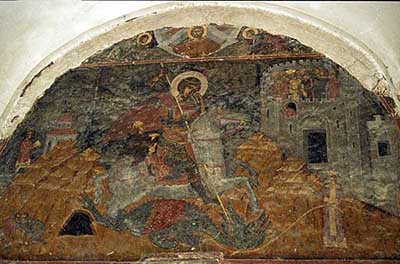Alaverdi

Alaverdi is a monument of Georgian architecture, monastic complex, the center of Alaverdi Episcopate.
It is located in the Alazani-River valley, near the village of Alaverdi (Akhmeta Municipality), 20 km from Telavi. Alaverdi Monastery was founded by Joseph of Alaverdi in the middle of the 6th century. At the beginning of the 11th century, King Kvirike of Kakheti built a large cathedral in the place of the small church of St. George, which is mainly known as Alaverdi. It is the highest cathedral in Georgia (41.7 X 26.4 m; up to 50 meters). Alaverdi cathedral is a triconch type of a building, just like the Bagrati cathedrals of Oshki and Kutaisi. The plan of the building is based on a cross; its three columns end with semicircular apses. However, all three apses of Alaverdi are within the rectangle of the outer walls, therefore the form of the cross is not drawn at the ground level, but rather created in space by the volumetric forms of the building.
The western part is elongated, has side naves. The dome erected at the intersection of the arms of the cross rests on four pillars. The apses that are close to each other are joined to the same pillars, by which they are directly connected to the space under the dome. The architect of the Alaverdi created a grandiose interior space (arguably the grandest in the entire Georgian architecture), which impresses the visitor. In this space, one can very clearly feel the characteristic features of Kakheti monuments. It is even more visible from the outside. The decoration of the facades of the cathedral is very sparse — this is also a peculiarity of Kakheti architecture; The wide planes of the huge walls, separated only by arches and niches, are very impressive. The traditional five-arched composition is also repeated on the eastern facade, but there are also some other decorations that the architects of that time also adopted — circumference and arches. The interior is well lit with plenty of light coming in from the wide windows and doors (the dome has 16 windows). In the north, south and west, the cathedral had open galleries, which were demolished at the beginning of the 19th century. The entrances are located on these three sides. The cathedral is mainly built of cobblestone. It is completely covered with yellowish tuff inside and outside. The building was covered with blue-glazed large tiles, fragments of which have survived to this day along with some of the inscriptions. Alaverdi Cathedral has been damaged by aggressors and earthquakes many times. During its first major restoration (during the reign of King Alexander I of Kakheti, in the 1480s), the neck of the dome and individual parts of the walls were completely restored. After the damage caused by the earthquake in 1742, the restoration was done by Erekle II. All restored parts of the cathedral are built with bricks. At the end of the 19th century, the interior of Alaverdi Cathedral was completely whitewashed. After the walls were cleared (opened in 1967), several layers of painting were revealed: the first and most important are the fragments of paintings of the 11th century. There are frescoes of the 15th–16th centuries on the southern walls, and frescoes of the 16th–17th centuries on the northern walls. The architectural complex of Alaverdi, which is surrounded by a fence (17th–18th centuries), combines buildings of different times. The reception hall, which is one of the most important buildings of this type in Georgia, is a three-story building (its lower floor is a vaulted hall, it was a refectory in the 16th–17th centuries). The brick palace of Paykar Khan was built around 1615. There are also other residential buildings, a bathhouse, a cellar, a bell tower and others. At first, Alaverdi was only a friary. In the 17th and 18th centuries, a nunnery was also established here, which housed the members of the royal family who were ordained as nuns. Alaverdi Cathedral was a powerful center of literary work. Many writers and calligraphers worked here. Philippe of Alaverdi (16th–17th centuries), Archbishop Zebede (17th century), Niceforo Irbachi (Nikoloz Cholokashvili, 18th century) are some of them. Mariam-Makrine Bagrationi-Cholokashvili (18th century) is especially distinguished. She was engaged in original creative work in hagiography and hymnography — reproduced manuscripts, wrote documents. Cultural and educational activities in Alaverdi Cathedral continued until the end of the 19th century (Kirile Amiranidze, Ioane Laradze).
In 2018, a small hall church built with cobblestone and lime mortar was discovered to the east of the complex, at a distance of 150 m from the fence. The external dimensions, including the apse, are 6.30 x 3.85 m, the height of the remaining walls is 0.7 m. There is a four-sided communion table in the apse. Initially, the parish part of the church was open on three sides (west, south and north), which were later built up.
During the excavation, no archaeological material from the original layer of the church was found.
According to architectural signs, the church was dated to the first half of the 6th century. As for the later layers, the first one probably dates back to the early Middle Ages, and the second one to the late Middle Ages.
Architects, who worked on the restoration of the monument at different times: L. Khimshiashvili, G. Cheishvili, Sh. Tsintsadze, N. Kereselidze, I. Mosulishvili and others.
Literature: ბერიძე ვ., ძველი ქართული ხუროთმოძღვრება, თბ.,1974; ჩუბინაშვილი გ., ქართული ხუროთმოძღვრება საშუალო საუკუნეებში და მისი სამი მთავარი კათედრალი, კრ.: არილი, ტფ., 1925; მისივე, Архитектура Кахети, Тб., 1959.
V. Beridze
L. Menabde


